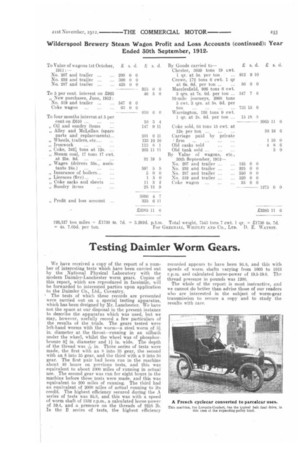Testing Daimler Worm Gears.
Page 9

If you've noticed an error in this article please click here to report it so we can fix it.
We have received a copy of the report of a number of interesting tests which have been carried out by the National Physical Laboratory with the modern Daimler-Lanchester worm gears. Copies of this report, which are reproduced in facsimile, will be forwarded to interested parties upon application to the Daimler Co., Ltd., Coventry. ' The tests of which these records are presented were carried out on s, special testing apparatus, which has been designed by Mr_ Lanchester. We have not the space at our disposal in the present instance to describe the apparatus which was used, but we may, however, usefully record a few particulars of the results of the trials. The gears tested were left-hand worms with the worm—a steel worm of 31 in. diameter at the throat—running in an oilbath under thewheel, whilst the wheel was of phosphorbronze 9a in. diameter and 11 in. wide. The depth of the thread was in. Three aeries of tests were made, the first with an 8 into 33 gear, the second with an 8 into 36 gear, and the third with a 9 into 34 gear. The first pair had been run in the machine about 40 hours on previous tests, and this was equivalent to about 1000 miles of running in actual use. The second gear was run for eight hours in the machine before these tests were made, and this was equivalent to 200 miles of running. The third had an equivalent of 2000 miles of actual running to its credit. The highest efficiency secured during the A series of tests was 93.8, and this was with a speed of worm shaft of 1532 r.p.m., a calculated horse-power of 59.4, and a pressure on the threads of 2258 lb. In the 11 series of tests, the highest efficiency recorded appears to have been 96.6, and this with speeds of worm shafts varying from 1003 to 1013 r.p.m. and calculated horse-power of 19,5-19.6. The thread pressure in pounds was 1200.
The whole of the report is most instructive, and we cannot do better than advise those of our readers who are interested in the subject of worm-gear transmission to secure a copy and to study the results with care.






















